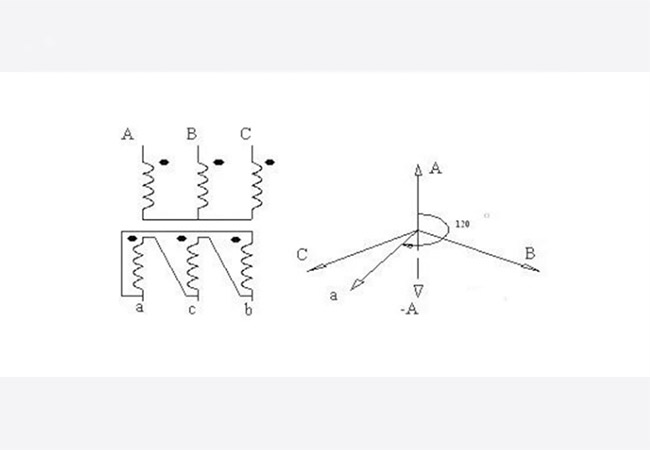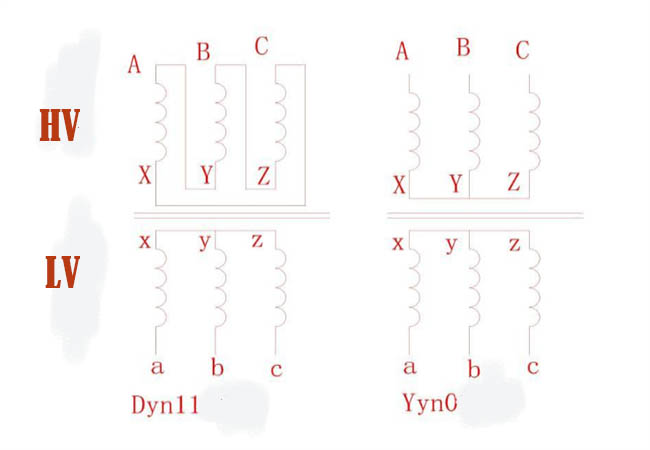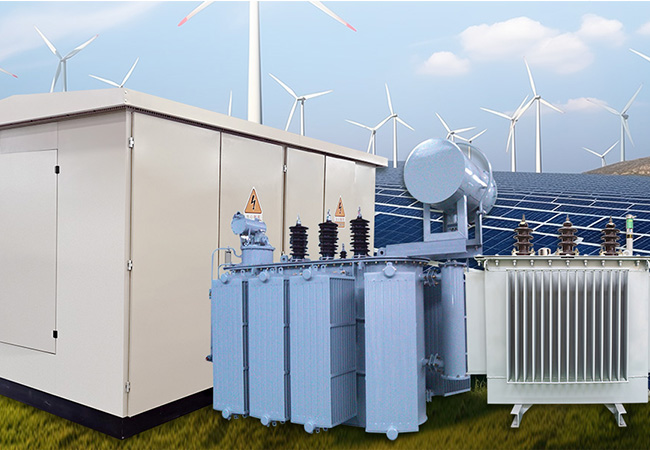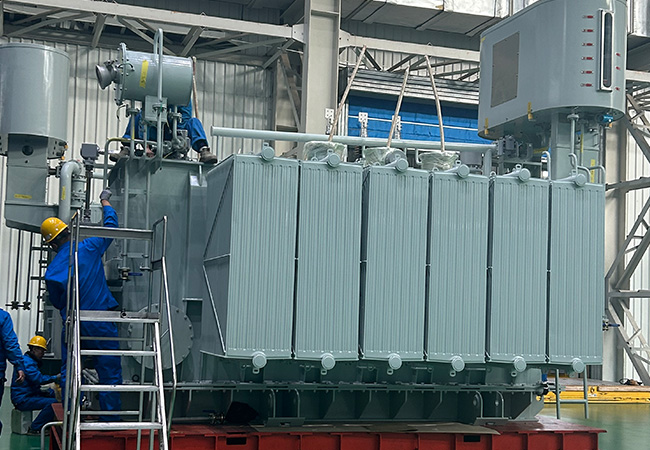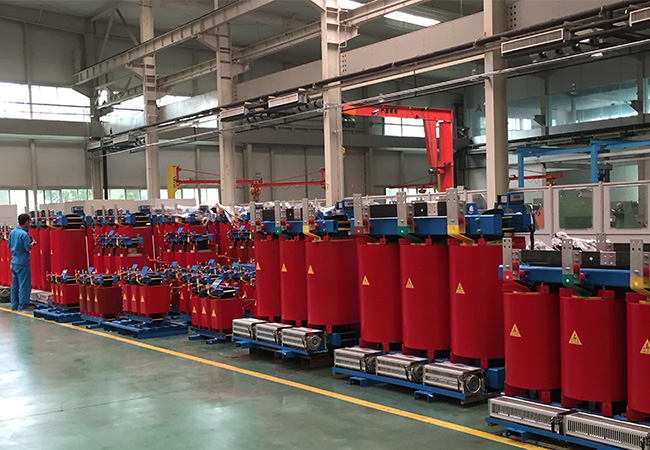Transformer connection groups Dyn11 and Yyn0 Differences and principles
05-29 2025 | By:
Transformer Dyn11 connection mode: triangle on high voltage side, star on low voltage side, neutral line, high voltage and low voltage phase difference of 30 degrees. Transformer Yyn0 connection mode: star on high voltage side, star on low voltage side, neutral line, no phase difference between high voltage and low voltage.
Yyn0: means high voltage Y connection, that is, star connection, low voltage is also y connection, low voltage neutral point is led out, high and low voltage side phase angle is 0 o’clock on the clock.
Dyn11: high voltage d connection, that is, triangle connection, low voltage is also y connection, high and low voltage side phase angle is the angle at 11 o’clock on the clock, 11 means that the line voltage on the secondary side of the transformer lags behind the line voltage on the primary side by 330 degrees (or more than 30 degrees).
In addition, the following knowledge:
Transformer high and low voltage have three connection modes: star, triangle and curved connection. High voltage windings are represented by symbols Y, D, Z (uppercase); medium and low voltage windings are represented by y, d, z (lowercase). When the neutral point is drawn, it is represented by YN, ZN (high voltage neutral point) and yn, zn (low voltage neutral point).
The numbers are represented by clock representation, indicating the phase relationship between the primary and secondary line voltages. The phase of the primary line voltage is used as the minute hand and is fixed at the 12 o’clock position of the clock, and the phase of the secondary line voltage is used as the hour hand.
In the two windings of the common part, the rated voltage of the autotransformer is lower than the rated voltage. The transformer is combined in the order of connecting the high and low voltage windings, that is, the winding connection group.
For example: the high voltage is Y, the low voltage is yn, and the winding is Yyn. In addition, the clock method represents the phase relationship between the high and low voltage sides as a connection group.
The combination of the two transformer windings forms four connection groups: Yy, Dy, Yd and Dd. Because there are two types of neutral lines and non-neutral lines when Y is connected, there is no additional symbol without a neutral line, and the neutral line is represented by adding the letter N after the letter Y. n means that there is a lead at the neutral point. Yn0 connection group, UAB and uab coincide, and both time and needle point to 12. In the new connection group, 12 is represented as 0.
The three common connection groups have different characteristics:
1.Y connection: The characteristic of star connection is that the high-voltage winding is the most economical. Star connection can reduce the insulation of the midpoint, so that the high-voltage winding of the transformer is graded and insulated, reducing costs. The voltage of the star line winding is equal to 1/√3 of the line voltage, and the winding current is equal to the line current. The neutral point lead wire of the star connection method can also be used for direct grounding or grounding through an arc suppression coil. If it is not grounded, a lightning arrester can also be connected to prevent operating overvoltage and lightning overvoltage. In addition, neutral point lead grounding can also be used to realize four-wire power supply. The main disadvantage of this connection is that there is no circulating circuit for the third harmonic current.
2.D connection: Delta connection is the most economical in the low-voltage winding of low-voltage, high-current transformers. Since the delta connection must be made into equal insulation and cannot be made into graded insulation, for the low-voltage winding, due to the low voltage, this has no effect. The current in each phase winding of the triangle line is only 1/√3 of the lead current. The triangle connection method can circulate zero-sequence current and third harmonic current in the winding, generate anti-magnetic flux that suppresses zero-sequence flux and third harmonic, and avoid the deformation of the induced electromotive force of the transformer.
3. Z junction: The Z junction has the advantages of the Y junction, the number of turns is 15.5% more than the Y junction, and the cost is higher. The zero-sequence impedance is small and it is suitable for manufacturing grounding transformers. Because it can reduce the neutral point displacement, it is suitable for manufacturing low-voltage windings of small and medium-capacity transformers that require three-phase unbalanced loads. In addition, it can also prevent lightning overvoltage.
The difference between Dyn11 and Yyn0:
Dyn11
Since the high-voltage side is a triangle connection, when zero-sequence flux or third harmonic flux appears in the transformer core, zero-sequence electromotive force or third harmonic electromotive force will be generated in the triangle winding. Since this induced electromotive force is three identical phases, it will be superimposed in series in the triangle winding to generate the corresponding current. This zero-sequence (third harmonic) circulating current generates reverse flux, which weakens the zero-sequence (third harmonic) flux in the core to a minimum, thereby reducing the neutral point voltage displacement of the low-voltage side star coil. At the same time, the zero-sequence (third harmonic) induced electromotive force in the high-voltage side winding is reduced to a minimum, avoiding the voltage waveform pollution in the high-voltage side power grid caused by the deformation of the low-voltage side load current waveform. Therefore, the triangle-connected transformer can prevent the influence of the third harmonic or zero-sequence flux on the high-voltage side power supply voltage waveform. In addition, this connection method is also very effective in preventing overvoltage caused by lightning intrusion waves. Since the three-phase lightning intrusion wave is also in the same direction, this situation is similar to the zero-sequence current, and the circulating current generated by the triangle winding also has an inhibitory effect on the lightning current flux generated by the three-phase core of the transformer.
GB/T13499-2002 “Guidelines for the Application of Power Transformers” stipulates that the zero-sequence impedance of the Yyn transformer is as high as 60%, and the neutral line current shall not exceed 10% of the rated current; the zero-sequence impedance of the Dyn transformer is only 0.9 times the positive-sequence short-circuit impedance, and the neutral line can carry the rated current.
However, if the drop-out fuse is used for overload and short-circuit protection on the power supply side of the Dyn11 connected transformer, one phase fuse will be blown, that is, the single-phase line on the high-voltage side will be disconnected. At this time, there is a two-phase phase voltage on the low-voltage side, and its value is 1/2 of the rated voltage, that is, it drops from 220V to 110V. At this time, household appliances such as refrigerators will not be able to start and will burn out. At this time, reliable low-voltage protection must be added to the low-voltage end of the Dyn11 connected transformer.
Yyn0
In this connection mode, there is a neutral line on the low-voltage side, and the third harmonic current in the low-voltage load and the zero-sequence current in the three-phase unbalanced load can flow through the neutral line in the transformer winding. If the core is three-phase and three-column, the third harmonic current and the third harmonic current generated by the winding cannot form a closed circuit in the core (because the third harmonic current flux and the zero-sequence flux in the three-phase core column are in the same direction), and can only cross the core and return to the core through the transformer insulation medium (transformer oil) and the iron metal of the box. Due to the large magnetic resistance of the insulating medium outside the core, the zero-sequence flux and the third harmonic flux are small. However, the zero-sequence electromotive force and the third harmonic electromotive force induced by them are superimposed on the phase voltage, resulting in asymmetric three-phase voltage, resulting in neutral point displacement, some phase voltages rising, and other phase voltages falling. In order to prevent serious asymmetry of three-phase voltage and affect the normal power consumption of users, the industry standard SD-292-1988 “Overhead Distribution Line and Equipment Operation Regulations (Trial)” stipulates that the imbalance degree of three-phase load shall not exceed 15%. A small amount of single-phase load is allowed for three-phase transformers, but the neutral line current shall not exceed 25% of the rated current. Therefore, this regulation is to limit the neutral point displacement voltage to about 5%.
If the transformer with Yyn0 connection has a three-phase five-column structure as its core, the zero-sequence (or third harmonic) magnetic flux in the core can flow through the side columns, which has a much smaller magnetic resistance than when it flows through the box body. Therefore, the zero-sequence (or third harmonic) magnetic flux is much larger than that of the three-phase three-column transformer, and the zero-sequence (or third harmonic) electromotive force induced in the winding is much larger, the neutral point voltage is seriously displaced, and the three-phase voltage imbalance increases. Therefore, the transformer of the Yyn0 connection group does not adopt a three-phase five-column structure or a three-phase transformer connection method.
You may also find these interesting:
